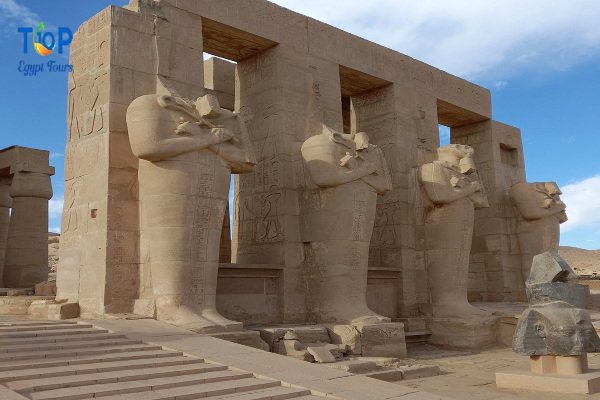Ramesseum Temple of Ramses II, Nestled on the west bank of the Nile River in the ancient city of Thebes, the Ramesseum stands as a testament to the grandeur of ancient Egyptian architecture and the might of one of its greatest pharaohs, Ramesses II. As part of the cluster page “Egyptian Ancient Thebes: Luxor and Karnak Temples,” Top Ten Egypt takes us to this awe-inspiring temple, where history, art, and spirituality converge to create an unforgettable experience.
Architectural Marvels Of Ramesseum Temple of Ramses II:
We must not leave the west bank of Luxor without talking about the great mortuary temple of Ramses II Called Ramesseum, Although it is very ruined.
This temple covers 270×165 m .
Ramesseum Temple of Ramses II was placed beside and in alignment with an earlier sanctuary built by Seti I .
It begins as usual with a pylon through which we enter the first court . This court, flanked by two colonnades, is opened to the royal palace situated on its southern side.
The main sanctuary was in the center and the room of the sacred boats was the north of the small hypostyle hall.
This temple and the adjoined storerooms and administrative buildings were surrounded by an enclosure made of mud – bricks.
The Mortuary Temple:
The main structure, the mortuary temple, was dedicated to the funerary cult of Ramesses II. Visitors can explore the inner sanctuaries, chapels, and rooms adorned with scenes of religious ceremonies and offerings. The central axis of the temple leads to the sanctuary, where the pharaoh’s statue would have once stood.
Colossal Statue Remains:
While wandering through the Ramesseum, one cannot miss the colossal fallen statue of Ramesses II, famously known as the “Younger Memnon.” This statue, weighing over 1,000 tons, originally stood at the entrance of the temple. Today, it lies in ruins but continues to captivate with its colossal size and intricate detailing.
Osirian Statues:
A distinctive feature of the Ramesseum is the presence of Osirian statues – colossal seated figures of Ramesses II that depict him in the guise of Osiris, the god of the afterlife. These statues symbolize the pharaoh’s desire for eternal life and his association with the divine.
Despite the ravages of time and history, the Ramesseum has endured as a symbol of ancient Egypt’s cultural and architectural achievements. Ongoing preservation efforts by archaeological teams ensure that this magnificent temple remains accessible to present and future generations.
The Ramesseum, with its towering structures and rich historical significance, offers a captivating glimpse into the life and legacy of Ramesses II. As part of the cluster page “Egyptian Ancient Thebes: Luxor and Karnak Temples,” a visit to the Ramesseum is not just a journey through time but an immersive experience into the heart of ancient Egyptian civilization. Join us as we unravel the mysteries and marvels of this extraordinary temple, discovering the stories etched in stone by the hands of the pharaohs.



Comment (0)